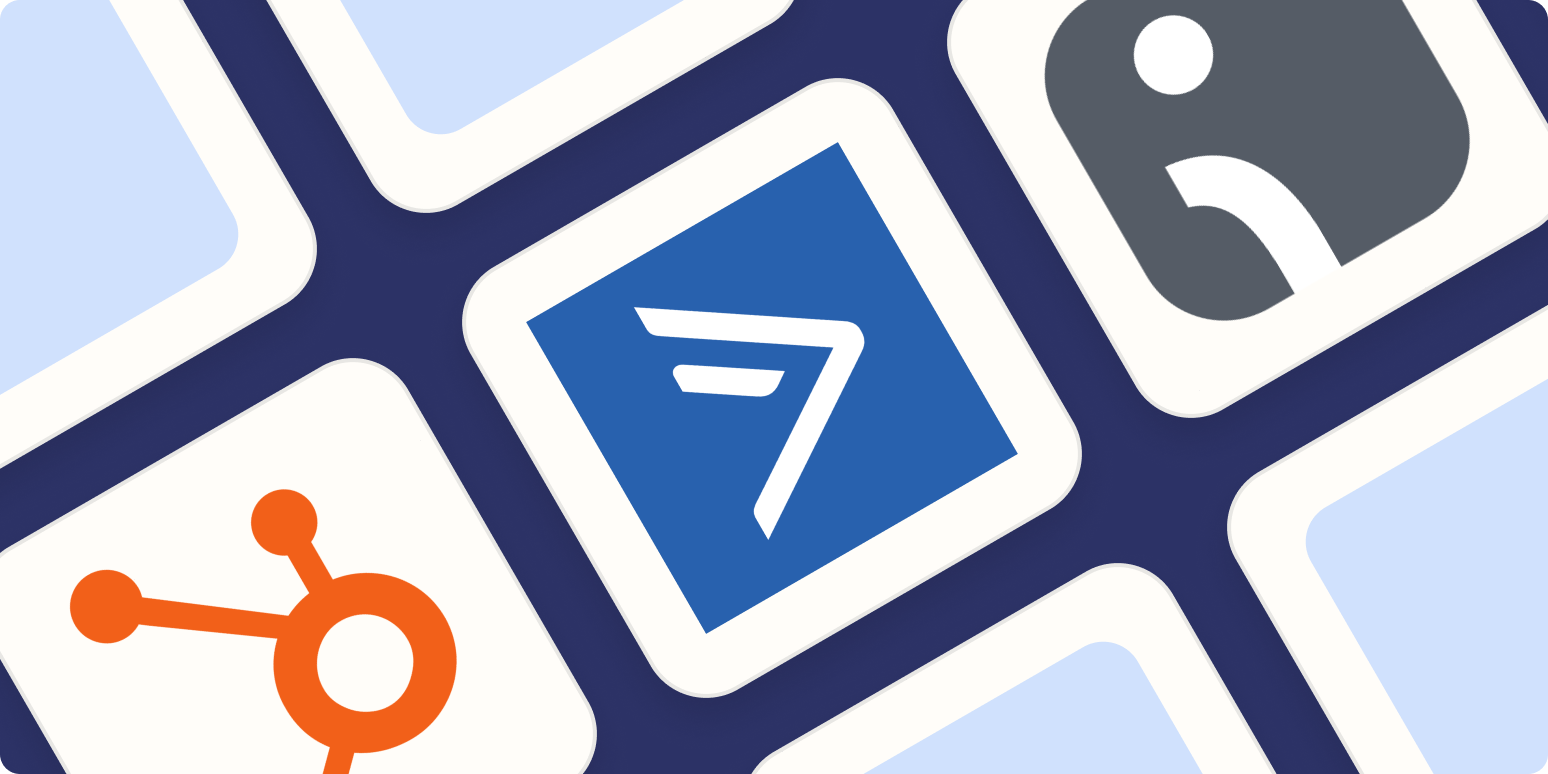Do you remember your first marketing moment? Mine was passing out flyers I made for my band’s upcoming shows. I’d walk around my college campus and chat with students I thought might be interested. If you were wearing flannel—this was the early ’90s—you got a flyer. I measured ROI by the familiar faces I saw in the audience.
Grow your business with marketing automation
This form of marketing feels outdated now, but the basic concepts and goals haven’t changed—only the technology has. Marketing automation software replaces the flyers, the hours of walking, and my eye for spotting the right audience. And that’s just the tip of the iceberg.
I’ve been working with marketing automation software since early on in its evolution. For this article, I evaluated several dozen marketing automation solutions and did in-depth testing to determine which would appeal to a broad spectrum of marketers with different business needs and goals. After weeks of testing, here are my picks for the five best marketing automation platforms.
The best marketing automation software in 2022
-
HubSpot for a platform that will grow with your business
-
ActiveCampaign for providing prebuilt automations
-
Omnisend for affordable eCommerce marketing automation
-
EngageBay for small businesses wanting all-in-one software
-
Marketo for businesses with lots of contacts
What is marketing automation software?
Marketing automation is a ridiculously broad term with a lot of different definitions being thrown around. So I’ll toss my hat in the ring: marketing automation software is technology that automatically manages multi-channel marketing activities (campaigns). It has features that include things like:
-
Lead capture (CTAs, forms, landing pages)
-
Lead nurture
-
Email and/or SMS marketing
-
Website visitor tracking
-
Social media management/marketing
-
List segmentation
-
Lead scoring
-
A/B testing
-
Reporting/analytics
-
Integration options
Ultimately, marketing automation platforms are designed to maximize efficiency and increase revenue, making the marketer’s job less manual and more accountable.
What makes the best marketing automation software?
How we evaluate and test apps
All of our best apps roundups are written by humans who’ve spent much of their careers using, testing, and writing about software. We spend dozens of hours researching and testing apps, using each app as it’s intended to be used and evaluating it against the criteria we set for the category. We’re never paid for placement in our articles from any app or for links to any site—we value the trust readers put in us to offer authentic evaluations of the categories and apps we review. For more details on our process, read the full rundown of how we select apps to feature on the Zapier blog.
There are lots of apps that do one or another kind of marketing automation (drip email apps are a great example). But for this list, we’re looking at apps that do it all. Or as close as you can get. I eliminated more enterprise-level platforms such as Salesforce/Pardot, Oracle, and SAP, so we could focus on the marketing automation tools that would best serve small and medium businesses.
Each of my selections for the best marketing automation tools checks the following boxes (at minimum):
-
Marketing automation. See the list above for some of the specific features. While some marketing automation is internal (e.g., notifying your team when certain thresholds are met), much marketing automation is the process of sending automated, targeted communication (e.g., emails and texts) to a defined list (segment) of contacts who you want to perform certain actions (e.g., buy, subscribe, champion).
-
Integrations. Anyone who interacts with customers, especially sales and customer service teams, should have a 360-degree view of all customer interactions. The top marketing automation platforms connect—either natively or through a tool like Zapier—to the other apps you use in your business, so no customer data falls through the cracks.
-
Ease of use. The point of marketing automation services is to make your life easier, so I prioritized ease of use while testing. All of the apps on this list have either intuitive instructions within the user interface, robust how-to libraries, solid customer support, or some combination of all three. (My advice: use all of the resources provided by the app, including onboarding, training, and migration assistance. The apps are easy to use, but they’re still complex beasts.)
-
Reporting. We know not all of your KPIs can be tracked automatically, but your software should do the heavy lifting. The apps on this list all offer both prebuilt and custom reporting. I also gave extra points for a native Google Analytics integration to help track any additional data not included in the provided reports.
-
Relative affordability. Costs are going to vary dramatically when it comes to marketing automation software. In general, pricing is determined by the sophistication of plan features, number of contacts and/or monthly email sends), and in some cases, the number of users. To determine relative affordability, I compared similarly-priced plans and features as a starting point. Then I looked at the number of included users and contacts and the pricing for additional contacts. It was by no means an exact science, but it allowed me to better compare apples to apples.
I signed up for trial accounts of each app and jumped in. I set up the ability to send emails and texts, created a handful of contacts, and designed some emails and texts to be used in the automations. I also created pop-ups, forms, and landing pages to get a feel for how easy they were to build, and I experimented with lists and segmentation (how targeted can I get with my contacts?). Finally, I built automations and/or campaigns using what I had created.
After an initial review of dozens of apps, I revisited the top contenders, and finally narrowed it down to these five marketing automation platforms.
Best marketing automation software for growing your business
HubSpot (Web, iOS, Android)
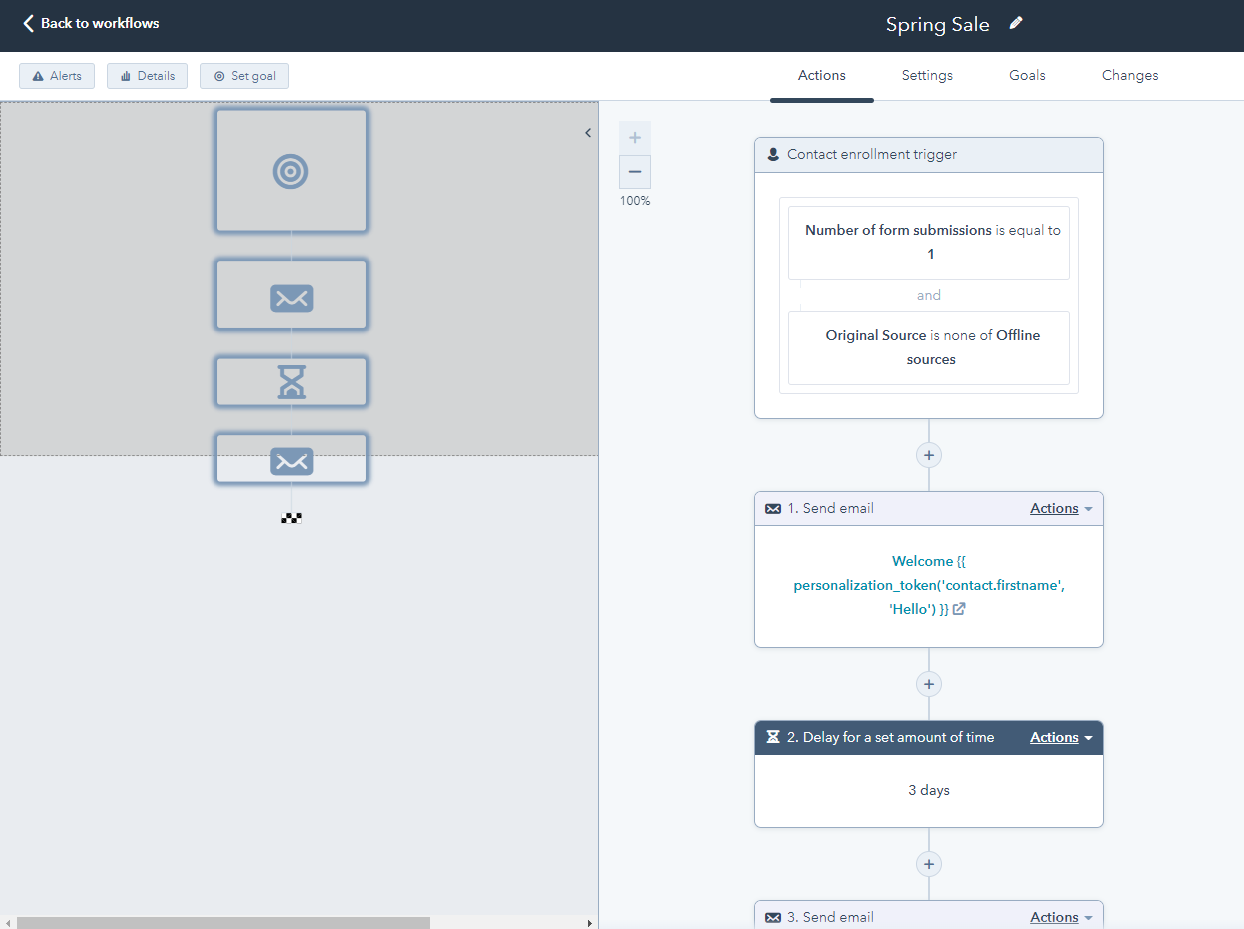
During my years working at a marketing agency, I’ve seen firsthand how HubSpot has contributed to the growth of many businesses. When I started working with it in 2013, HubSpot was “just” marketing automation software. Now it has five hubs—marketing, sales, service, CMS, and operations—to manage different areas of your business. But for our purposes, I’ll focus primarily on the marketing suite.
First, I need to acknowledge something important: HubSpot is easy to use. The UI is uncluttered, the knowledge base is one of the best in the business, and the user community is just a click away.
HubSpot offers a lot for free, including a very capable CRM and live chat. When you purchase any of the paid plans, you get to remove branding from your emails and landing pages, among other things, plus all your limits increase. And HubSpot is known for inbound marketing, which means you’ll get top-notch SEO tools too: a quick scan of your site will give you recommendations like “address pages with duplicate title tags” with specific instructions on how to fix them. Regardless, you’re starting off with quite a bit at a reasonable price point.
HubSpot’s marketing automations are called workflows. You’ll find them under the Automations tab, and you’ll get about a dozen premade workflows, like nurturing conversions, welcoming new contacts, and re-engaging cold leads. This page also houses all your workflows in a searchable table. If you want to get a little more customized, you can start from scratch. You’ll be asked how you want the workflow to start (e.g., based on contact, company, deal, conversation, and so on). Let’s look at an example.
Say you choose contact as your starting point. You can then set what filters to use as a trigger (using and/or criteria), including categories like contact properties, page views, and company details. So you might trigger off of contacts that are decision-makers and have viewed your pricing page or where the company’s annual revenue is $5 million or less. Then you select your action: do you want to add that person to an email list? Send them an email? If you’re unsure what an action does or how to use it, there’s always a link to the knowledge base. Once you’ve reviewed and everything looks good, just turn it on.
Beyond these workflows, HubSpot’s marketing features are well-rounded: you get landing pages, CTAs, and forms; and on the social side of things, you can create and schedule posts, monitor activities, and analyze it all in a social analytics section that I was pretty impressed by, given that it’s not a dedicated app.
While we’re on analysis, HubSpot has the most extensive reporting for any marketing platform that I came across. In addition to general reports, you can create customizable dashboards with reports for different areas, such as email, channel, and website engagement. There are over 100 reports to choose from, and you can customize them with your own filters by report content (e.g., attributions, revenue, conversations) and report type (e.g., funnel, list, comparison). You can also track custom behavioral events, campaign analytics, forms performance, traffic analytics, and contact analytics. It’s a lot—and it’s done well.
When you need to integrate HubSpot with the rest of your tech ecosystem, HubSpot’s App Marketplace provides over 1,000 native integrations. Over the years, I’ve connected over a dozen apps to HubSpot, and the experience has always been straightforward. If you can’t find the app you’re looking for, or you need something a little more customized, you can connect HubSpot to Zapier to do things like adding a new Facebook lead or Google Contact to HubSpot.
HubSpot price: Marketing automation starts at $800/month for unlimited users and includes 2,000 contacts (CRM is free). HubSpot’s pricing is mostly based on how many users or marketing contacts you have.
Best marketing automation software for prebuilt automations
ActiveCampaign (Web, iOS, Android)
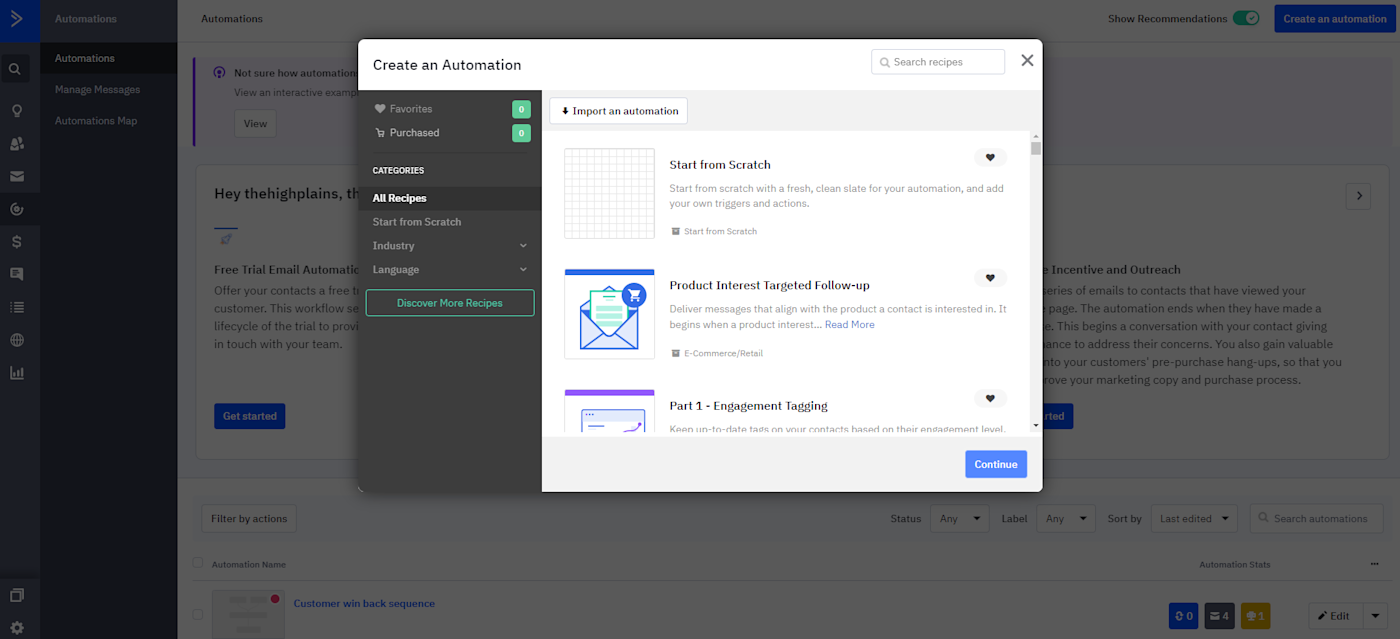
ActiveCampaign includes over 500 prebuilt automation “Recipes,” so whether you’re new to producing campaigns or just need fresh ideas, you’ll find what you need. You can search by industry or language, and it feels like there’s a Recipe for every occasion, from accessory upsell after purchase to engaging prospects interested in pricing. (Or you can start from scratch, but honestly, you probably won’t need to.)
I selected Customer Win Back Sequence and was brought to a page with an editable view of the campaign steps. The campaign is already built for you, but you can add additional triggers (e.g., visits a web page, reads an email) to add contacts to this series. You’ll also have to create the email or SMS copy and/or the site messages they’ll receive, but you’ll get templates for these too—nothing is really “from scratch” if you don’t want it to be. From there, you can pick (or edit) conditions in the workflow and update contacts in your CRM or other connected apps. You can even use integrations within a Recipe (e.g., sending physical gifts using a third-party gifting platform). And you can add if/then conditions to personalize the journey even more.
To help increase your email click rates, ActiveCampaign offers a unique feature: predictive content in emails. When creating an email, drag the predictive content block into the body. You’ll be asked to create up to five variations of text (and you’ll get suggestions based on what you write). When the email is sent, ActiveCampaign will predict which content each contact should receive based on an analysis of every email the company’s customers send and how people interact with them.
When it comes to analytics, ActiveCampaign’s prebuilt vibes continue. You’ll get plenty of prebuilt reports for automations, where you can track email performance and even revenue generation when you’re connected to an eCommerce store. The conversion attribution report shows the effectiveness of all touchpoints (e.g., email campaign, Facebook ad) that led to a converted sale, and custom reports let you set the parameters for the data you want to collect from multiple sources.
If you’re moving from another marketing platform, ActiveCampaign will migrate your contacts and recreate your automations, landing pages, and templates at no cost. The integration suite is also one of the largest I saw other than HubSpot, so you’ll have no trouble keeping your data connected. And you can add even more apps by connecting ActiveCampaign to Zapier to do things like adding new contacts whenever someone fills out a form or books an appointment.
ActiveCampaign price: From $9/user/month with 500 contacts. If you’d like another communication channel, a Conversations add-on ($19/user/month) provides live chat and a unified inbox that can be shared with your team to monitor and respond to chats.
Best marketing automation software for eCommerce
Omnisend (Web)
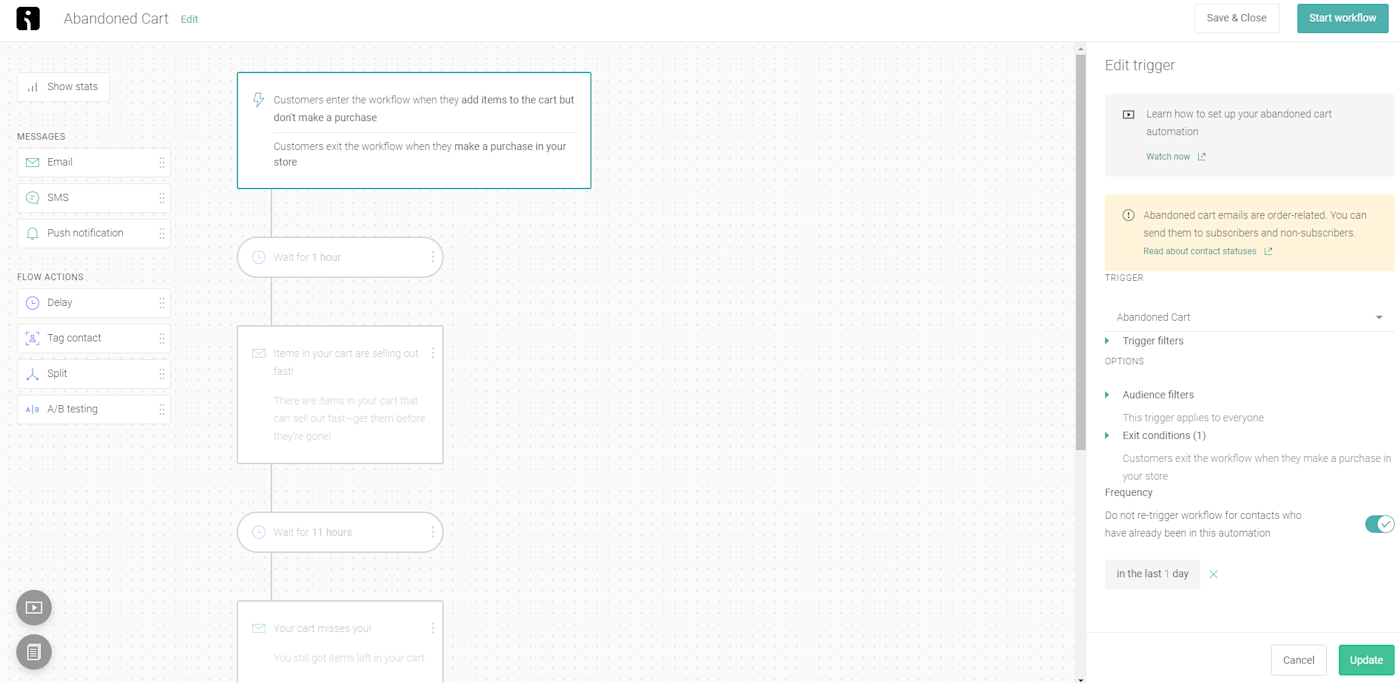
Because of the low starting price and low cost to add contacts, Omnisend is your best bet for an affordable eCommerce marketing automation platform. The top-tier plan is only $59/month for 500 contacts, unlimited email sends, and nearly 4,000 SMS/month. Contact tiers are then charged at about $5 per 500 contacts (that’s about $0.01/contact). And even with the free plan, you get access to 95% of the features, just with limitations.
Omnisend offers an impressive selection of segmentation options under the Audience tab. The prebuilt segments include categories like “at risk of churn,” “viewed a certain product,” and over a dozen more. Click on one, and then customize it with filters and conditions. For example, with “at risk of churn,” you can filter by lifecycle stage and contact properties using and/or logic to add additional filters. When creating a segment from scratch, you can add more filters for events: things like pages viewed, marketing activities (opens and clicks), and events from your eCommerce store (e.g., “order shipped” and “viewed product”).
Designing emails is simple, with a selection of premade sections to choose from. For example, when you add the product recommender block, Omnisend pulls 2 – 4 products from your store (you choose either best sellers or newest products), with images, prices, and links to display in the email. The data is pulled from your store each hour, so the product recommendations are always the most up to date. The unique discount block lets you generate discount codes in your eCommerce platform, add them to emails, and specify the value (percentage or fixed amount) and how it’s applied (all orders, minimum order price). Then you can set the expiration date for the discount. Not bad for an email block.
There are about 30 prebuilt eCommerce-related workflows, and you can customize them or start from scratch. All workflows start with a trigger (e.g., viewed page, order placed). You can then filter those triggers based on things like order total and which product was purchased. You can also add audience (contact) filters to further refine who enters the workflow. Once you’ve defined the trigger, you have message options for email, SMS, and— notably—push notifications, and you can add actions with delay, tag, split, and A/B test. Any step you add that isn’t complete will be highlighted in red with what’s needed—a nice touch.
The reporting is solid. You’ll get overall reporting on best and worst performing campaigns and workflows plus more detailed reports on things like campaign revenue attribution. Plus there’s a click map, which shows which elements of a campaign your subscribers clicked on.
Adding to the eCommerce experience, Omnisend integrates natively with Shopify, WooCommerce, BigCommerce, Magento, Wix, OpenCart, and plenty of other eCommerce platforms, plus apps for customer support, shipping, reviews, and advertising. For my testing, I connected a free WooCommerce account on my WordPress site and then integrated that easily with Omnisend. There are no native CRM integrations, but you can take care of that with Zapier, so you can do things like add new HubSpot or Salesforce contacts to Omnisend.
Omnisend Price: Free plan available to reach 250 contacts/month and send 500 emails/month; Paid plans start at $16/month and increase that to 500 contacts/month reached and 6,000 emails/month.
Best all-in-one marketing automation for small business
EngageBay (Web, iOS, Android)
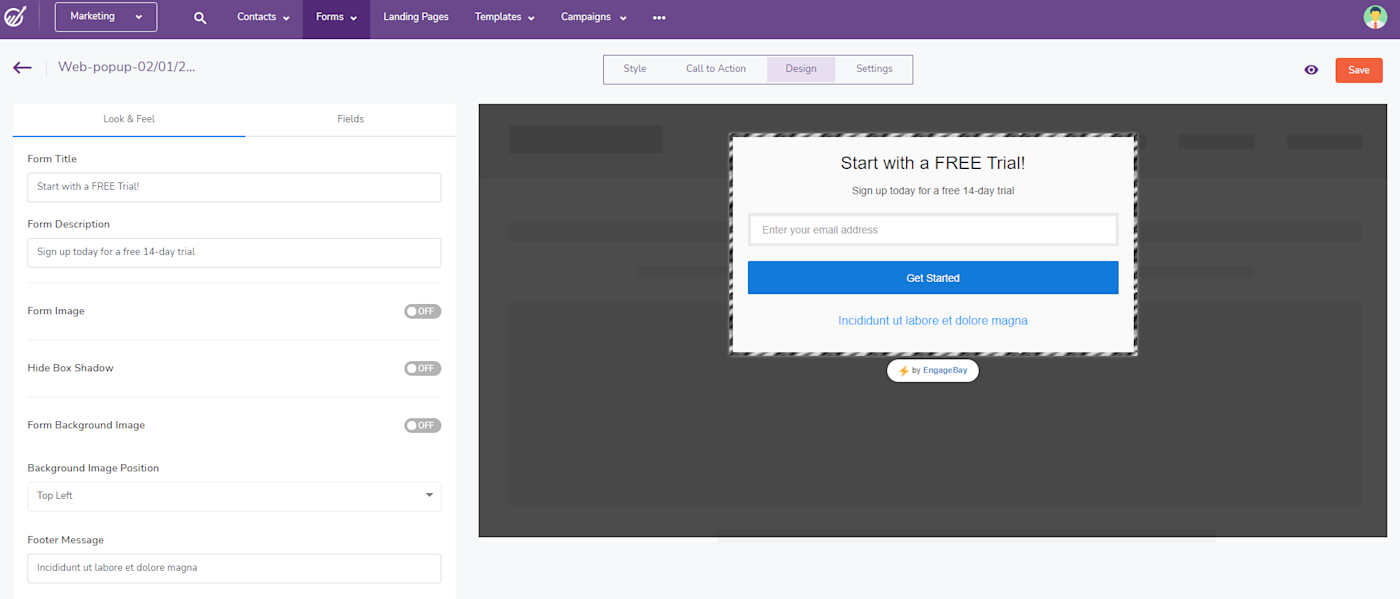
EngageBay is a solid platform for smaller businesses that want a relatively affordable solution with marketing, sales, and service capabilities baked into one. It’s thoughtfully designed so that anyone can jump in, and as I found out, their support is always just a quick chat away.
Marketing is the most robust suite by far: in addition to automation, it offers landing pages, forms, pop-ups, site messages, and push notifications. I created a few pop-ups and a landing page, and they all got the job done. For most small businesses, the sales and service suites will offer plenty of functionality. The sales suite has a drag-and-drop deals pipeline, tasks, automations (sequences), proposals, and a 360-degree view of all activities for contacts. For service, you’ll get a shared inbox where you can assign, monitor, and automate ongoing tickets, as well as a help center and service dashboard.
You can create static and dynamic contact segments by choosing from and combining about 50 conditions, including contact details (e.g., lead score, company, state) and other attributes (e.g., pages visited, contact source). One nice touch that’s worth mentioning: the drag-and-drop email template builder had no trouble recognizing copy and pasted text from other apps like Google Docs, something I had a lot of trouble with on other apps.
Under Campaigns, you can create one-time broadcasts (email and SMS), sequences, and automations. Sequences are kind of like drip campaigns: it’s a group of emails sent to subscribers at different times, with exclusions for things like tags, contacts, and date. I liked that you could see all the emails in a sequence at once on one side of the screen while you’re customizing any specific email. You’ll also get plenty of easy-to-add email templates, and the ability to record and save video templates from your computer’s camera.
Though the automations are plenty capable, the experience setting one up wasn’t quite as intuitive and well-designed as some of the other apps on this list. It’s a combination of clicking plus signs, selecting actions, dragging lines from triggers to actions, and a few other things. There also weren’t instructions or prompts, so you’ll be flying by the seat of your pants to start. But once I got used to the process, it was fine.
The Marketing Dashboard shows the performance for all the different activities you have running, and you can also drill down into specific automations, landing pages, or forms to see how they’re each performing. You can create custom reports for any metric you’re collecting.
To make sure your marketing automation software is talking to the rest of your apps, you can connect EngageBay to Zapier to do things like add new customers or form respondents to EngageBay.
EngageBay price: From $39/user/month for marketing automation, CRM, and service suites. The free tier and lower-priced plans do not include marketing automation.
Best marketing automation software for businesses with lots of contacts
Marketo (Web, iOS, Android)
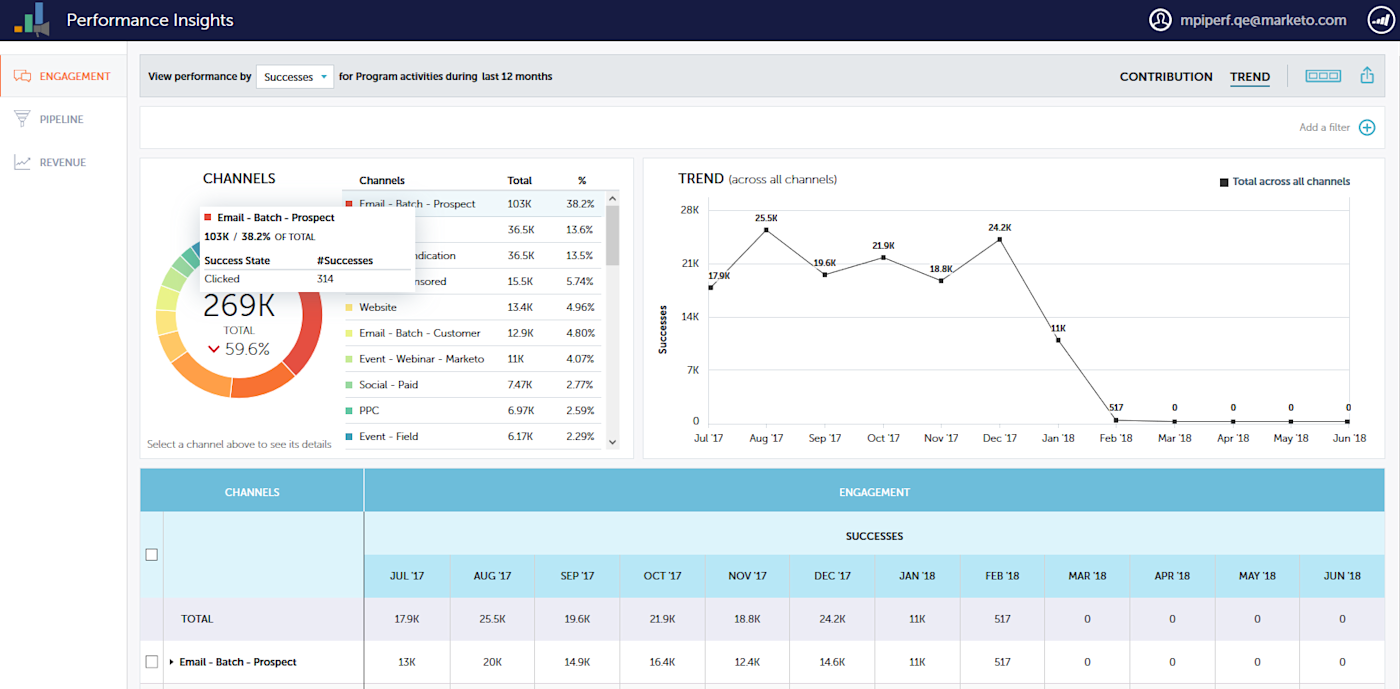
Because of its cost and complexity, Marketo isn’t really a “first-time” marketing platform. It’s overkill for most small and even some medium businesses, depending on your goals and the size of your contact database. But it’s not quite enterprise-only, and it’s a leader in the space—for good reason. It offers a lot of features, flexibility, and customization options that make it a very powerful platform.
There’s a really nuanced level of refinement available for audience segmentation and targeting, including custom fields. You can take that segmentation even further by using dynamic content, which automatically personalizes content for emails, web pages, and landing pages for the segments you’ve created. For example, you might want to send several segments the same basic email but with a different subject line and slightly different copy—and all it takes is a couple clicks to get there. You can do the same thing for your website, serving up personalized content, images, and messages based on filters you select for items like account/lead attributes and behavior.
At the heart of Marketo is what’s called a Program (essentially a campaign), which can include emails, SMS, landing pages, and more. You’ll start by creating a smart list (e.g., people from New York with a lead score of at least 75 and a status of “marketing qualified lead”). Then you’ll build out your flow, which can be as complex as you want it to be with branching. You can even automate marketing events (think: tradeshows and webinars) by creating invitations, reminders, and check-ins.
Marketo also offers SEO monitoring, which isn’t super common in this category of app. While not as sophisticated as a standalone app like Semrush, Marketo gives you a good starting point, letting you monitor 500 keywords, 5 competitors, and 3 domains. And because Marketo automatically crawls your site, it will identify page optimization issues and link opportunities, and make keyword recommendations.
The reporting is equally as impressive. You’ll get all the basics, but with custom dimensions, you can also see email data filtered for different segments and tags as well as different marketing activities. The “People Performance” report measures database growth over time, and the “Company Web Activity” report displays the companies of the people visiting your website, among other things. The reports in Revenue Explorer show the ROI, costs, and success for a given program and channel.
Marketo offers native Google, Facebook, and LinkedIn integrations, so you can run targeted ad campaigns based on your Marketo segments. You can also use Google AdWords and Facebook for retargeting audiences with data such as referring URLs, behavior, industry, and other factors. And you can connect Marketo to Zapier to do things like creating leads from form submissions or spreadsheets.
Note: Marketo doesn’t provide trials—we tried!—so I was unable to test it in the same way at the same time I was testing the other apps up for consideration. We rarely include an app we can’t test in tandem with the others, but I’ve spent time in Marketo in the past, so I felt comfortable reviewing it based on that previous experience (and cross-referencing current documentation and other materials to be sure my previous experience was still accurate).
Marketo price: Marketo’s pricing (not published) is based primarily on contact levels, with a minimum of 10,000 contacts as the starting point for any of the three plans. My Marketo contact said most customers at this level will pay between $1,250/month and $1,700/month for 10 users. There’s also a one-time integration fee.
How to choose the best marketing automation platforms
If selecting the right marketing automation software seems a little overwhelming, that’s because it is. It’s a big decision with many considerations. To help, I spoke to a few agency marketers to get more insights into how businesses should approach their search for a platform and some of the challenges they see.
Allison Gibbs, VP of Operations at Texas-based Mojo Media Labs, compares marketing automation to a gym membership. “When you first start, you have access to everything at the gym. But the reality is: are you going to use everything? No, but you’re still going to see value out of it.” Allison says you need to understand from a very high level what your goals are—taking the platform out of the equation. Once you understand your objectives and the “why,” then you can match the features up to that platform.
Sacha Gauthier is a Senior Strategist at Blend Marketing Ltd., based in the UK. One of the biggest challenges he sees with clients and marketing automation is with integrations. “Nowadays, most marketing functions rely on a lot of different platforms. The number one pain point is going to be something that doesn’t integrate into whatever marketing automation platform exists.” He likes platforms with native integrations or third-party connectors such as Zapier, so he doesn’t need to rely on developers and can more easily make campaigns with multiple apps work together. Regardless, his advice is to be sure your marketing automation platform will play nice with the rest of your tech stack.
[adsanity_group align=’alignnone’ num_ads=1 num_columns=1 group_ids=’15192′]
Need Any Technology Assistance? Call Pursho @ 0731-6725516

